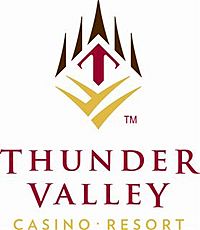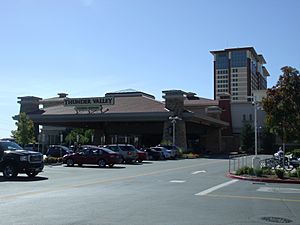Thunder Valley Casino Resort facts for kids
Quick facts for kids Thunder Valley Casino Resort |
|
|---|---|
 |
|

Thunder Valley Casino Resort in 2013
|
|
| Location | Lincoln, California, U.S. |
| Address | 1200 Athens Avenue |
| Opening date | June 9, 2003 |
| Theme | Lincoln, California, U.S. |
| No. of rooms | 300 |
| Total gaming space | 144,500 sq ft (13,420 m2) |
| Notable restaurants | Cafe Food Court: Fatburger, Panda Express, Peet's Coffee & Tea, Pizza Hut and Subway High Steaks Red Lantern The Buffet |
| Casino type | Native American |
| Owner | United Auburn Indian Community |
| Architect | JMA Architecture Studios |
| Renovated in | Expansion: July 2010 |
| Coordinates | 38°50′27″N 121°18′44″W / 38.84083°N 121.31222°W |
Thunder Valley Casino Resort is a large hotel and entertainment center. It is located in Whitney, California, near Lincoln, California. This spot is about 30 miles (48 km) northeast of Sacramento.
The United Auburn Indian Community owns and runs the resort. It was designed by architect Edward Vance. Thunder Valley first opened its doors on June 9, 2003. It offers many types of games and activities. The facility is very large, covering 275,000 square feet (25,550 m²).
Contents
The Story of Thunder Valley
Thunder Valley Casino Resort belongs to the United Auburn Indian Community. This is a Native American tribe made up mostly of Miwuk and Maidu people. These groups have lived in the Sacramento Valley area for a very long time.
In the 1950s and 1960s, the U.S. government changed the status of many Native American lands. This included the lands of the Miwok and Maidu Auburn band. To help their community grow and improve, the tribe decided to build a casino. This was possible after the tribe's official status was restored in 1994. This allowed them to get land under their own rules.
The United Auburn Indian Community made an agreement with California in 1999. This agreement allowed them to have certain types of gaming on their land. This agreement was updated in 2004.
JMA Architecture Studios designed Thunder Valley. The PENTA Building Group built it. The casino opened in June 2003. Later, it was made even bigger. This expansion started in March 2009 and finished in July 2010.
The United Auburn Indian Community tries to follow state and local land rules. They do this even though they don't always have to. For example, they chose to follow a California environmental law. Only a few tribes do this.
Games and Entertainment
The resort has over 3,000 slot machines and video games. There are also 125 table games, like blackjack. A special room is set aside for live poker games. This room can hold up to 160 players.
Thunder Valley often has special events and promotions. These can include drawings for prizes. They also have cash prizes and game tournaments.
What Else Can You Do There?
The big expansion finished in 2010 added a tall, 17-story luxury hotel. This hotel has 408 rooms, including 46 fancy suites. Inside the hotel, there is a large hall called Pano Hall. It can host up to 1,000 guests for events. There are also meeting rooms, bars, and a gift shop.
The hotel has a swimming pool area. It features private cabanas and a poolside bar called Coconut. In total, the resort has 14 different restaurants and bars.
The spa at the resort offers many relaxing treatments. These include facials and massages. You can also get pedicures and manicures. There is a sauna, a whirlpool, a steam room, and a health club.
Thunder Valley Casino Resort also hosts many concerts and shows. These events take place in their outdoor amphitheater during the summer.
Giving Back to the Community
The money earned from Thunder Valley helps the United Auburn Indian Community. They give about $1 million each year to groups in Placer County. Some groups that have received help include the Lighthouse Counseling & Family Resource Center. Others are the Sutter Auburn Faith Hospital Foundation and Foothill Volunteer Center.
In January 2005, the tribe gave $250,000 to Habitat for Humanity. This money helped with relief efforts after a big earthquake and tsunami in Asia in 2004.
In January 2010, the tribe donated $50,000 to Partners in Health. This helped with their work after the 2010 earthquake in Haiti.

